Professional certification, trade certification, or professional designation, often called simply certification or qualification, is a designation earned by a person to assure qualification to perform a job or task. Not all certifications that use post-nominal letters are an acknowledgement of educational achievement, or an agency appointed to safeguard the public interest.
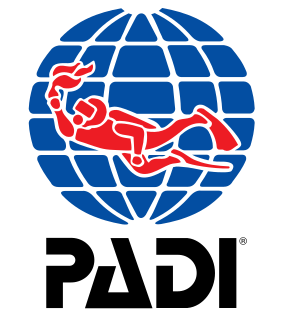
The Professional Association of Diving Instructors (PADI) is a recreational diving membership and diver training organization founded in 1966 by John Cronin and Ralph Erickson. Cronin was originally a NAUI instructor who decided to form his own organization with Erickson, and to break diver training down into several modular courses instead of the single universal course then prevalent.
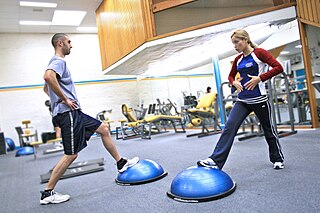
A personal trainer is an individual who has earned a certification that demonstrates they have achieved a level of competency for creating and delivering safe and effective exercise programs for apparently healthy individuals and groups or those with medical clearance to exercise. They motivate clients by collaborating to set goals, providing meaningful feedback, and by being a reliable source for accountability. Trainers also conduct a variety of assessments beginning with a preparticipation health-screening and may also include assessments of posture and movement, flexibility, balance, core function, cardiorespiratory fitness, muscular fitness, body composition, and skill-related parameters to observe and gather relevant information needed to develop an effective exercise program and support client goal attainment. These assessments may be performed at the beginning of and after an exercise program to measure client progress toward improved physical fitness. They also provide education on many other aspects of wellness, including general health and nutrition guidelines. Helping clients to reach their full potential in various aspects of life requires a comprehensive client-centered approach along with a belief that clients are resourceful and capable of change.
A divemaster (DM) is a role that includes organising and leading recreational dives, particularly in a professional capacity, and is a qualification used in many parts of the world in recreational scuba diving for a diver who has supervisory responsibility for a group of divers and as a dive guide. As well as being a generic term, 'Divemaster' is the title of the first professional rating of many training agencies, such as PADI, SSI, SDI, NASE, except NAUI, which rates a NAUI Divemaster under a NAUI Instructor but above a NAUI Assistant Instructor. The divemaster certification is generally equivalent to the requirements of ISO 24801-3 Dive Leader.
The National Association of Underwater Instructors is a non-profit association of scuba instructors. It primarily serves as a recreational dive certification and membership organization established to provide international diver standards and education programs. The agency was founded in 1960 by Albert Tillman and Neal Hess. NAUI is headquartered in the Tampa, Florida area with dive and member instructors, resorts, stores, service and training centers, located around the world.
Golf instruction is the art of equipping and training golfers to play better golf through improved awareness of swing cause and effects as a result of the actions by their body, the club, and their effect on the golf ball. Most great golfers have a few common elements that make them great including: proper intentionality, swing repeatability to produce an action that fits the golfers intentionality, and a strong level of automaticity for long lasting enjoyment of the game golf. Golf instruction is unique as golf consists of five primary skills: shots from a tee, full shots from the ground (mostly known as "iron shots", pitching (or 3/4 shots designed for distance control, chipping, putting and course strategy or gamesmanship.

A certified first responder is a person who has completed a course and received certification in providing pre-hospital care for medical emergencies. Certified individuals should have received much more instruction than someone who is trained in basic first aid and cardiopulmonary resuscitation (CPR) but they are not necessarily a substitute for more advanced emergency medical care rendered by emergency medical technicians (EMTs) and paramedics. First responders typically provide advanced first aid level care, CPR, and automated external defibrillator (AED) usage. The term "certified first responder" is not to be confused with "first responder", which is a generic term referring to the first medically trained responder to arrive on scene and medically trained telecommunication operators who provide pre-arrival medical instructions as trained Emergency Medical Dispatchers (EMD). Many police officers and firefighters are required to receive training as certified first responders. Advanced medical care is typically provided by EMS, although some police officers and firefighters also train to become emergency medical technicians or paramedics.

Ski patrols are organizations that provide medical, rescue, and hazard prevention services to the injured in ski area boundaries, or sometimes beyond into backcountry settings. Many have technical-medical certifications, such as Outdoor Emergency Care (OEC) provided by the National Ski Patrol (USA), that are specific to the winter-season environment and providing emergency medical services in remote locations. Many patrollers also hold EMS issued credentials, such as emergency medical technician or any other pre-hospital care certification. Due to the remote location and terrain, transportation is often limited to ski toboggan, snowmobile, or, for life-compromising injuries or extremely remote terrain, helicopter rescue. Depending on the ski area terrain, ski patrollers can be versed in a large variety of specialized rescues, such as avalanche search and rescue, outdoor emergency transportation, chairlift evacuation, and, in some cases, helicopter rescue techniques are taught. Patrols work to promote ski safety, enforce area policies, and help the injured within their jurisdiction. Ski patrollers also work to set up the mountain before it opens by conducting trail checks, providing avalanche control work, and setting up necessary equipment in preparation for the day. At the end of the day, they also conduct a sweep clearing the mountain for off-hours.
The Arlberg technique is a progressive system that takes the skier from the snowplough turn to the parallel christie through measured stages of improvement. The system, or slightly modified versions, remains in widespread use to this day. Modern ski equipment is also capable of a more efficient turning style known as carving that uses entirely different techniques and movements. Some ski schools have started moving students directly from the snowplough to carving as early as possible, avoiding learning stemming habits that may be difficult to un-learn.

A teaching assistant or teacher's aide (TA) or education assistant (EA) or team teacher (TT) is an individual who assists a teacher with instructional responsibilities. TAs include graduate teaching assistants (GTAs), who are graduate students; undergraduate teaching assistants (UTAs), who are undergraduate students; secondary school TAs, who are either high school students or adults; and elementary school TAs, who are adults.
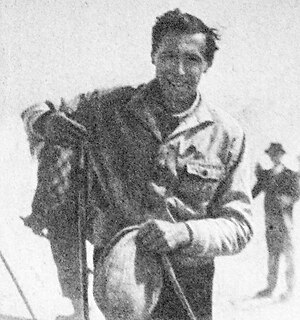
Johann "Hannes" Schneider was an Austrian ski instructor of the first half of the 20th century, famous for pioneering the Arlberg technique of instruction.
The Canadian Ski Patrol is a national, non-profit, registered charitable organization that is volunteer-based and provides advanced first aid and emergency response services at more than 230 ski resorts and nordic centres, as well as hundreds of recreational and sporting events across Canada. The Canadian Ski Patrol (CSP) has more than 4,500 registered members consisting of alpine and nordic skiers, snowboarders, and non-skiers/boarders, making it the largest volunteer-based certified first responder organization in Canada. Members of the CSP are involved in accident prevention and intervention, managerial activities, and patroller and public education.

A flight instructor is a person who teaches others to operate aircraft. Specific privileges granted to holders of a flight instructor qualification vary from country to country, but very generally, a flight instructor serves to enhance or evaluate the knowledge and skill level of an aviator in pursuit of a higher pilot's license, certificate or rating.
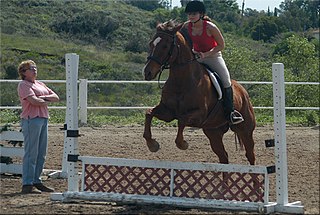
A riding instructor is a person whose job it is to teach methods of horse riding to beginners and improve the intermediate and advanced rider's style and technique. A riding instructor may also serve as a coach for a rider in competition. Some instructors may work out of their own riding facility, others at a riding school or training center. With appropriate academic credentials, some may teach in a college or university equestrian studies program. Yet others freelance and travel from stable to stable.
The Canadian Ski Instructors' Alliance (CSIA), founded in 1938, is an association of more than twenty thousand professional skiers located across Canada. The CSIA's purposes are to ensure a nationwide ski teaching standard through the development of effective skiing techniques and teaching methods and promote the importance of ski safety. The organization grants four general levels of certification, as well as several module certifications, such as snow park instruction, mogul skiing, and super giant slalom skiing. Each successive level demonstrates competence in ski instruction, pedagogy, as well as individual ski performance. As such, the highest level (four) is difficult to attain, with only a handful of instructors holding that level within each region. Lately, the CSIA came up with a merit certification for ski instructors that were part of the organization for twenty-five or more consecutive years. The celebrated members are normally awarded a "25-year member" pin, as well as a certificate, recognizing their efforts in the field.
NASTAR is the world's largest known recreational ski and snowboard race program. It allows ski or snowboard racers of all ages and abilities, through a handicap system, a way to compare themselves with one another and with the national champion, regardless of when and where they race. Since the program's beginning in 1968, more than 6 million NASTAR racer days have been recorded. It has been available at more than 100 ski resorts in North America and 1 in Australia. Many U.S. Ski Team stars got their start ski racing in NASTAR programs.
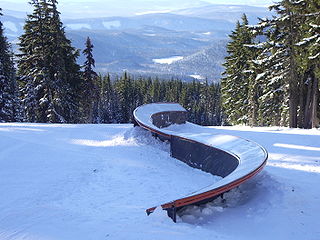
The following outline is provided as an overview of and topical guide to skiing:
Gray Rocks was a year-round privately owned resort in the Laurentian Mountains of Quebec, Canada, first developed as a ski destination on Sugarloaf Hill. The ski hill had 22 downhill trails: 4 easy, 10 intermediate, 8 expert. Also available was a snowboarding park and instruction from the Snow Eagle Ski School.

A professional fitness coach is a professional in the field of fitness and exercise, most often instruction, including professional sports club's fitness trainers and aerobics and yoga instructors and authors of fitness instruction books or manuals.
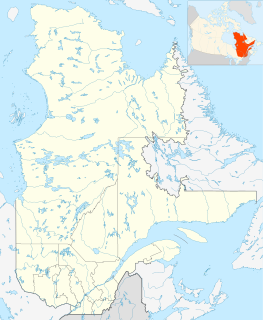
Ski Montcalm is an alpine ski resort in Rawdon, Québec, Canada. The mountain, which is in the Lanaudière region, has operated since 1969. The ski area is distributed on three mountainsides, with twenty-four trails. Ski Montcalm is a member of the Quebec Ski Area Association (ASSQ).











